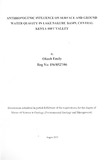| dc.description.abstract | Lake Nakuru basin is located in Nakuru district in the Central Kenya Rift. The study area extends
between the bounds of 35o 50’ 35’’E to 36o 15’ 47.5’’E and 0o 09’ 21.8’’S to 0o 42 ‘ 56.5‘’S The
study area is divided into three sub basins namely Nakuru West, Nakuru East and Nakuru North.
Nakuru West is generally endowed with a lot of streams traversing it and it contributes a large part
of the catchment area that drains into Lake Nakuru. The hydrology of the study area is dependent
on the catchment supply through rivers.
The objective of this study was to determine spatial variation of chemical (Na, K, Mg, Ca, NO3
SO4, Cl and HCO3) and physical characteristics (pH, TDS and Conductivity) of surface and
groundwater quality and the sources of pollutant (SO4, Cl and NO3) in relation to human activities/,
soil and geology of Lake Nakuru basin. The approach involved chemical and physical analyses of
major ions. A total of 51 deep boreholes, 3 shallow boreholes, 3 springs and 21 river samples were
collected and analyzed for the major ionic composition. The data was analyzed and interpreted
using SPSS, AquaChem and ArcGis computer programs.
The results indicate that chemical composition of dissolved ions are in the increasing order of Na+,
K+,Ca2+, Mg2+ (cations) and HCO3-, Cl-, SO42-, NO3- (anions) for both surface water and
groundwater. Groundwater is characterized by average mean of 403.99 mg/l TDS, 823.20 µS/cm
conductivity and 7.68 pH. Surface water on the other hand is characterized by mean 287.85 mg/l
TDS, 577.67 µS/cm and 7.65 pH.
From the results it is deduced that there is spatial variation in composition of water resources in the
study area. Surface water is Na-HCO3 to Na-Cl facies whereas groundwater is Na-HCO3 to Na-ClSO4
type in the study area. Both surface water and groundwater are fresh and alkaline.
Anthropogenic sources of pollution have greatly affected surface water as compared to
groundwater. The origin of major ions in groundwater is mostly attributed to weathering of silicate
rocks, natural process through precipitaion and anthropogenic contribution is significant. The nonpoint
source of pollution of groundwater in the study area
It is recommended that interconnection between surface and groundwater should be determined.
This will be helpful in future monitoring by giving information on how pollutants move in the
environment and extent of water pollution. This is done by injecting a trace element into one of the
rivers (e.g river Njoro at its source) in the study area whose flow is structurally controlled. The
point along the river into which the element is injected acts as a reference point. The movement of
the tracer element to groundwater will be monitored by analyzing samples from the boreholes.
Samples that will be found to contain the tracer element in their composition are likely to be
interconnected. The above process can be repeated to the other rivers one at a time until the
interconnection is determined. | en |

